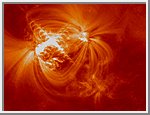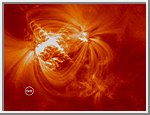
| Table of Contents |
|
Solar Atmosphere Gets Hot Sun Corona Animation Dancing Coronal Loop Images Sun Introduction |
| Solar Discoveries |
|
Sun Exploration Chronology Sun's Place in the Galaxy Solar Mystery Nears Solution Solar Flare Leaves Sun Quaking Sun Picture/Animation Gallery |
| Educator's Guides |
|
Guide to Convection Guide to Eclipses Guide to Sunspots |
This friction, called viscosity, may help explain why the corona is more than 100 times hotter than the Sun's surface, a mystery that has occupied solar researchers for decades.
"Just as a guitar string vibrates when plucked, coronal loops move back and forth after being disturbed by a flare. The new TRACE observations show that, rather than vibrating like they are in thin air, the loops act as if they are trying to vibrate in something much thicker, like pudding," said Dr. Leon Ofman, chief scientist at Raytheon ITSS working at NASA's Goddard Space Flight Center, Greenbelt, Md. "This rapidly halts their swaying motion -- it stops after twelve minutes or so. If the original theories on coronal viscosity were correct, the loops would continue vibrating for more than a week."
"People have been studying the Sun for centuries. We expected progress, but few major surprises. To have a discovery like this is tremendously exciting," said Dr. Richard Fisher, mission scientist for TRACE.
Viscosity is a measure of the friction, or resistance to flow, in a fluid. Pudding is harder to stir than water because pudding has greater viscosity. High viscosity is responsible for the annoyingly slow flow of ketchup and molasses. The research will be published in the August 6 issue of Science. Dr. Valery Nakariakov, postdoctoral fellow at St. Andrews University, Scotland, is first author on the paper.
The greater than expected viscosity in the corona may help resolve a solar conundrum. The discovery that the Sun's atmosphere is much hotter than its surface seems contrary to the physical law that heat does not flow from a cooler object to a warmer one -- it is like discovering people heating their homes with ice cubes. Solar physicists suspect that magnetic energy produced by the roiling, electrically charged gases on the solar surface is somehow transferred to the corona, heating it.
"We thought magnetic energy could be used to heat the corona, but our old theory of a low viscosity corona made the process so inefficient that we could not see how it was done. Our new discovery reveals a high viscosity corona, which means it has a lot of friction. Brakes heat up when used to stop a wheel from turning because their high friction efficiently converts the wheel's motion to heat. If you put oil on the brake, you reduce its friction -- the wheel turns much longer, and the brake never gets very hot. Similarly, a high viscosity corona with a lot of friction can be used to transfer energy and generate heat much more efficiently," said Ofman.
"The discovery would not have been possible without the high resolution of the TRACE spacecraft," said Fisher. "We can see fine structure in the coronal loops, and the high rate at which TRACE takes images lets us see rapid changes."
"One of the goals of the TRACE mission was to make all of the data immediately available to the entire scientific community. This fundamental discovery was made by an independent scientist taking advantage of the open data policy," said Dr. Alan Title, principal investigator on TRACE.
TRACE is equipped with a special telescope that can see extreme ultraviolet radiation emitted by the hot gasses in the solar corona. This radiation is absorbed by the Earth's atmosphere and is not visible from the ground.
TRACE is a Small Explorer mission and the science instrument was developed by teams at the Stanford Lockheed Institute for Space Research, Smithsonian Astrophysical Observatory, Montana State University, and Goddard.
Bill Steigerwald Goddard Space Flight Center Aug. 5, 1999 Greenbelt, MD William.A.Steigerwald.1@gsfc.nasa.gov Phone: 301-286-5017
| Top Image | Middle Image | Bottom Image |
|---|---|---|
 |
 |
 |
| Earth Comparison | ||
 |
 |
 |
 |
All Three Images | |
Coronal loops, immense coils of hot gas on the surface of the Sun, vibrate wildly after the blast wave from a solar flare hits them. The flare is the bright area in the top left of each image, with surrounding coronal loops below and to the right. The X-shaped starburst pattern is just an instrument artifact.
In the middle and bottom images, the displacement of the bottom loops is prominent as the flare blast wave hits them and they snap back to their original position. This causes them to vibrate back and forth for several minutes.
However, their dance is quickly squelched by resistance from the Sun's outer atmosphere (corona). The corona restricts motion due to internal friction hundreds of millions of times greater than expected, according to recent observations from NASA's Transition Region and Coronal Explorer (TRACE) spacecraft. This friction, called viscosity, may help explain why the corona is more than 100 times hotter than the Sun's surface, a mystery that has occupied solar researchers for decades.
Just as a guitar string vibrates when plucked, coronal loops move back and forth after being disturbed by a flare. The new TRACE observations show that, rather than vibrating like they are in thin air, the loops act as if they are trying to vibrate in something much thicker, like pudding. This rapidly halts their swaying motion -- it stops after twelve minutes or so. If the original theories on coronal viscosity were correct, the loops would continue vibrating for more than a week.
Solar physicists suspect that magnetic energy produced by the roiling, electrically charged gases on the solar surface is somehow transferred to the corona, heating it. However, the old theory of a low viscosity corona made the process so inefficient that scientists could not see how it was done. This new discovery reveals a high viscosity corona with a lot of friction that can be used to transfer energy and generate heat much more efficiently. (Courtesy NASA/Leon Ofman, Raytheon Scientific Visualization Studio/Tom Bridgman)